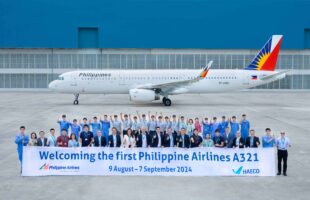
Philippine Airlines, Inc. (PAL) said its losses reach around US$1,780 for every 30-minute delay in its flights due to the runway congestion at Manila’s Ninoy Aquino International Airport (NAIA). Jaime J. Bautista, president and chief operating officer of PAL, made the comments in New Zealand during a ceremony marking the inaugural Philippine Airlines four-times weekly flight from Manila to Auckland on 8 December.
“Many times we fly around Metro Manila for additional 20 to 30 minutes – we did an estimate of how much it costs us for a minute of delay because of congestion, it is around US$60 every minute on average,” Bautista said. The amount covers jet fuel, maintenance, and additional labor expenses. “Because we pay our pilots and cabin crew a basic pay and productivity pay based on flying hours. So that’s additional cost,” Bautista explained.
Asked if the flag carrier plans to move some flights to Clark International Airport in Pampanga as it did with select international flights out of Cebu’s Mactan International Airport, he replied: “Yes. Most of the airlines will be forced to fly to Clark if they would want to continue their expansion programme. We want to decongest Manila that’s why we’re operating in Cebu and soon we’ll have to operate in Clark,” he added, but did not disclose a target date. Bautista also announced PAL will be transferring its Manila-San Francisco (SFO) service from NAIA terminal 2 to terminal 1 starting from 8 December 2015 in order to “de-congest terminal 2”.
From 15 September to 15 November the carrier’s on-time arrival performance is 66 per cent, data from the Web site of airport information provider FlightStats, Inc. showed. Acknowledging there would always be internal delays due to maintenance and check-in issues, he said that barring external factors the checkin time should be around 95 per cent.
The Department of Transportation and Communications earlier said it recorded a total of 277,112 aircraft movements in 2013 alone – already surpassing the 274,880 target for 2016 under the 2011-2016 Philippine Development Plan. NAIA’s runways currently handle about 40 aircraft movements (landing and take-off events) an hour which is limited due to the fact the two-runway airport is constrained by intersecting runways which limit their full potential. This results in chronic congestion in aircraft movements, exacerbated by a rapidly growing domestic aviation market which leads to frequent flight delays and cancellations.
PAL’s listed parent firm, PAL Holdings, Inc., reversed last year’s PHP 322.16 million (US$6.83 million) net loss as it swung to a PHP 247.9 million profit in the third quarter, helped by the peso’s depreciation against the dollar and higher passenger revenues from new routes. For the first nine months, its net income ballooned by an annual 2,465 per cent to P6.11 billion.









